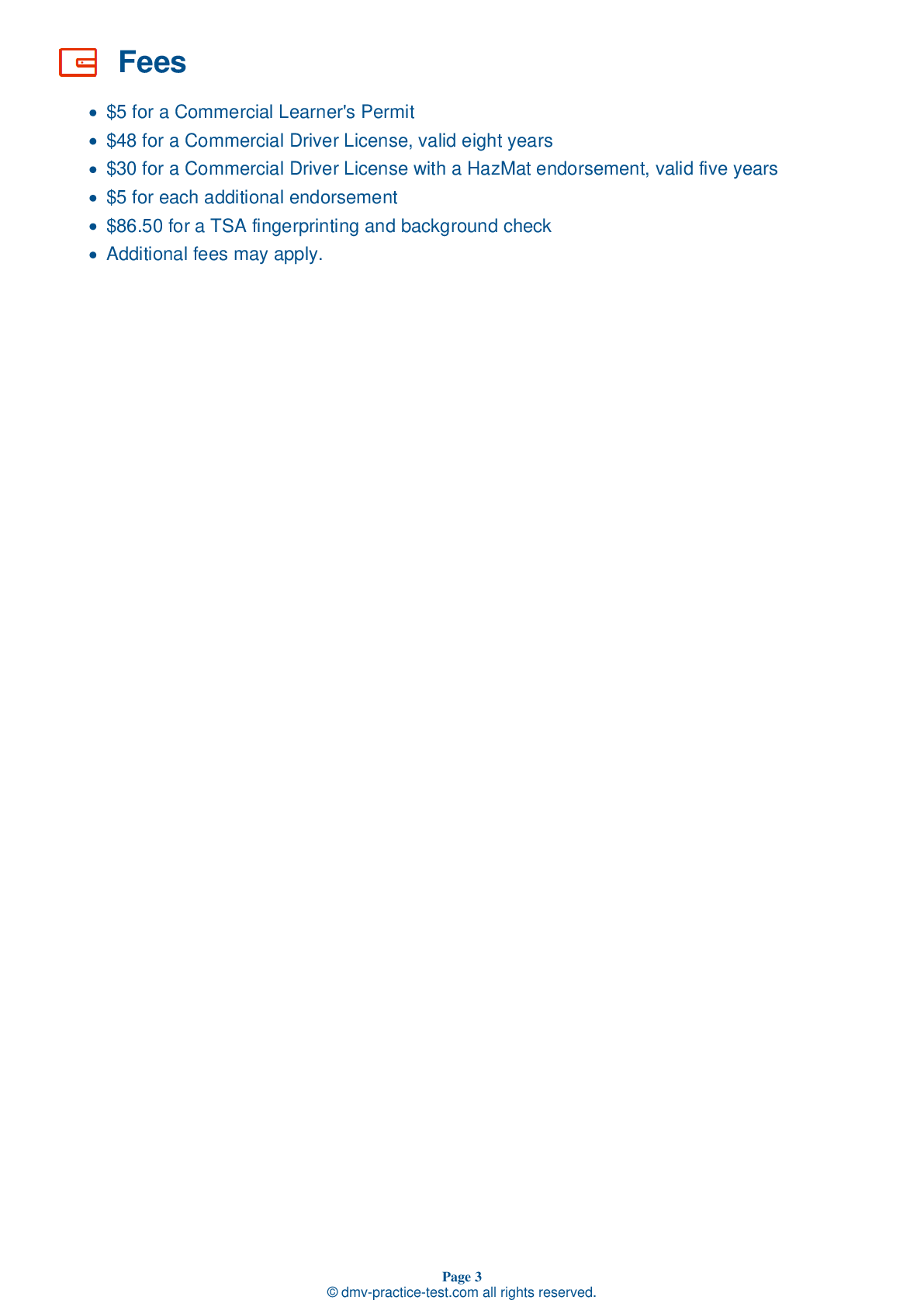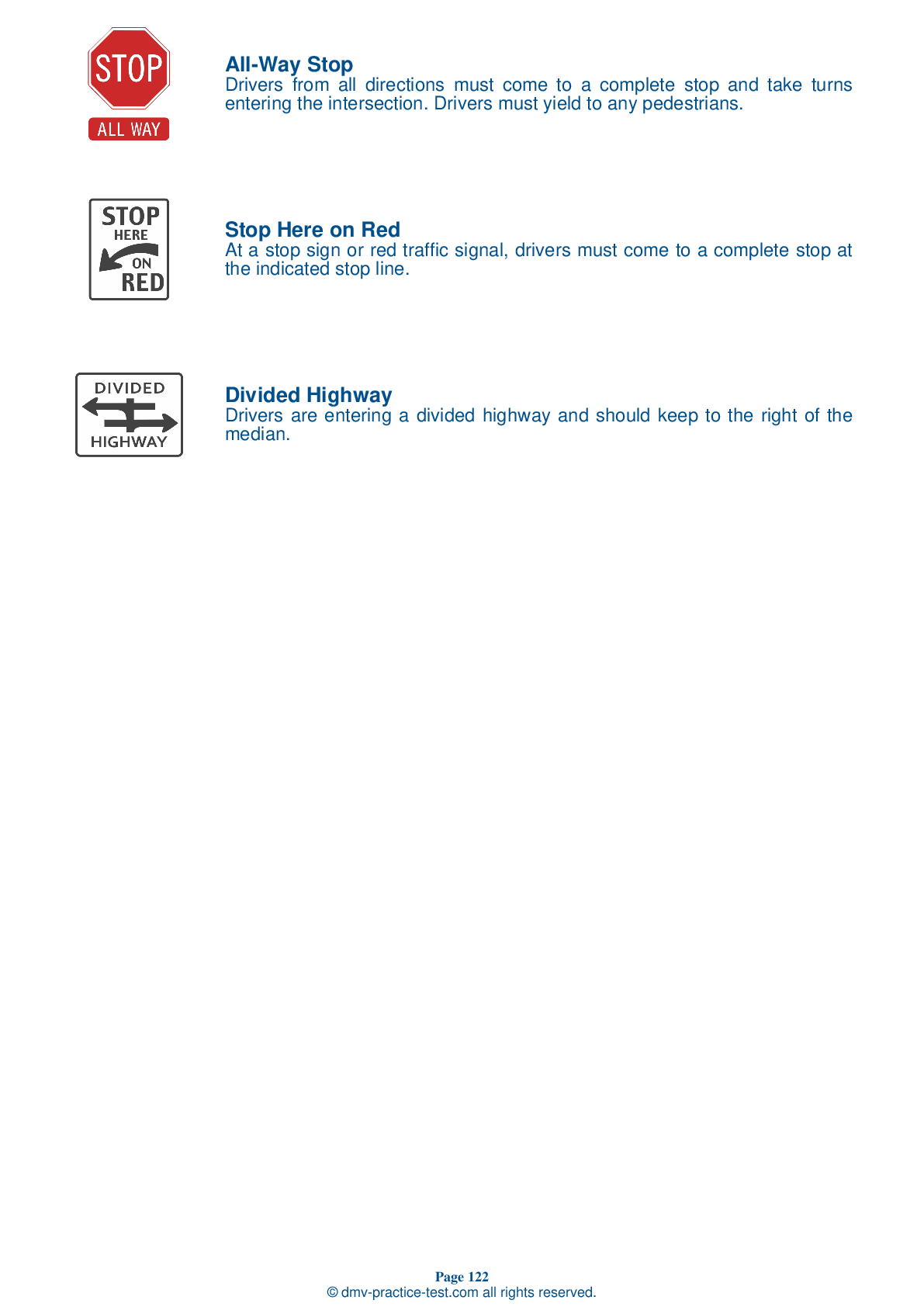Knowledge Test Class B #2
Class B Driving Test | Delaware 2025 #2 Page 3 of 7
Train for FREE online with our Delaware class B license test. The official exam test consists of several obligatory parts, with all of them checking your knowledge of different blocks of road rules. If you need to obtain a DE CDL class B permit in 2025, practice as much as possible. Free sample tests published on our website will help you check and improve your knowledge and boost your grades. Please bear in mind that CDL class B requirements may vary from state to state.
50
40
20
15 . The radiator cap:
Never remove the radiator cap or any part of the pressurized cooling system until it has cooled. Opening the cap while the system is too hot could release steam and boiling water that could severely burn you. If the radiator cap is cool to the touch, the system is likely cool enough for you to open the cap.
16 . In an engine compartment, loose belts will:
Last longer than tight belts.
Be sure to check the tightness of the belts in your engine compartment. Loose belts will not turn the water pump and/or fan properly, which can lead the engine overheating.
17 . Of the following, which is not a way to prevent drowsiness during a trip?
Avoiding medications that may cause drowsiness
Driving while fatigued can be extremely dangerous. Strategies for preventing drowsiness while driving include getting a full night's sleep before a trip; having someone ride with you so you can take turns driving; scheduling trips for times during which you are normally awake; and avoiding medications that may cause drowsiness.
18 . Move over laws require:
All vehicles to move to the left lane if a flatbed trailer is in the right lane.
If an emergency vehicle with its lights on is stopped on the side of the road, move over laws require drivers to vacate the lane directly next to the vehicle, if possible. If a driver cannot move over safely, they must slow down and proceed with caution.
19 . To obtain a CDL for interstate commerce, an applicant must be at least:
25 years old.
You must be at least 21 years old and have at least one year of driving experience to be licensed to drive in interstate commerce or to transport hazardous materials.
20 . When loading a trailer, weight should be:
Placed only on the right side, if possible.
Weight of cargo should be loaded into a trailer as low as possible. If the weight of cargo is positioned too high in a trailer, it will put the vehicle at risk of tipping over.
21 . During the driving test, when asked to make a lane change:
When asked to make a lane change during the on-road driving test, you should make the proper traffic checks, use your turn signal, and smoothly change lanes when it is safe to do so.
2025 Delaware | Frequently Asked Questions
To acquire a CDL Tank endorsement in Delaware, you must first have a Commercial Driver's License (CDL). Next, you'll need to pass a written knowledge test specific to tank vehicles. The test covers topics like inspecting tank vehicles, driving tank vehicles, and safe driving rules. The Delaware DMV offers study materials to help you prepare for the test.
To obtain a CDL Tank license, it's essential to already have a Commercial Driver's License (CDL). Then, you must pass a written knowledge test specific to tank vehicles. The test covers areas such as inspecting tank vehicles, driving them, and understanding safe driving rules. Preparation materials are available through the Delaware DMV to aid in your study for the test.
While specific training or experience is not mandatory for a CDL Tank endorsement in Delaware, it's highly recommended. Having practical experience or training can help you pass the specific written knowledge test, which covers areas such as inspecting and driving tank vehicles, and understanding safe driving rules. However, the requirement is passing the test, not prior training or experience.
Yes, an additional written knowledge test is required to obtain a CDL Tank endorsement in Delaware. This test focuses on specific areas related to tank vehicles, including inspection, driving, and safe driving rules. It's recommended to study the provided materials and guides from the Delaware DMV to prepare for this test.
The written test for the CDL Tank endorsement in Delaware covers subjects such as tanker truck inspection, proper loading and unloading procedures, safe driving techniques for transporting liquids or gases, and emergency response protocols. It also includes questions on understanding placards and hazardous materials regulations.
The CDL Tank endorsement assessment doesn't include a skills or maneuvers test. It only requires a written knowledge test. The test covers subjects like inspecting tank vehicles, safe driving rules, and driving tank vehicles. It's crucial to understand the high center of gravity in tank vehicles and how to handle surge, among other things.
Yes, there are some limitations. Drivers with a CDL Tank endorsement are only allowed to operate commercial motor vehicles designed to transport any liquid or gaseous materials within a tank. Additionally, the tank must have a rated capacity of 1,000 gallons or more. Also, certain hazardous materials may require additional endorsements.
No, transporting liquid or gas materials without a valid CDL Tank endorsement is illegal in Delaware. This endorsement is required to ensure that drivers have the necessary skills and knowledge to handle such materials safely. Violating this rule could result in serious penalties, including fines and suspension of the driver's commercial driving license.
Yes, a CDL Tank endorsement can be added to your existing CDL. You don't need to apply for a new license. However, you will need to pass the Tank endorsement written test. Upon passing, the Tank endorsement will be added to your current CDL, and you can then legally operate tank vehicles.
Yes, handling hazardous materials requires a separate Hazardous Materials (HazMat) endorsement in addition to the CDL Tank endorsement. Applicants must pass a written test, undergo a TSA background check, and be fingerprinted. Furthermore, carriers must follow specific federal and state regulations for packaging, labeling, and transporting hazardous materials.



